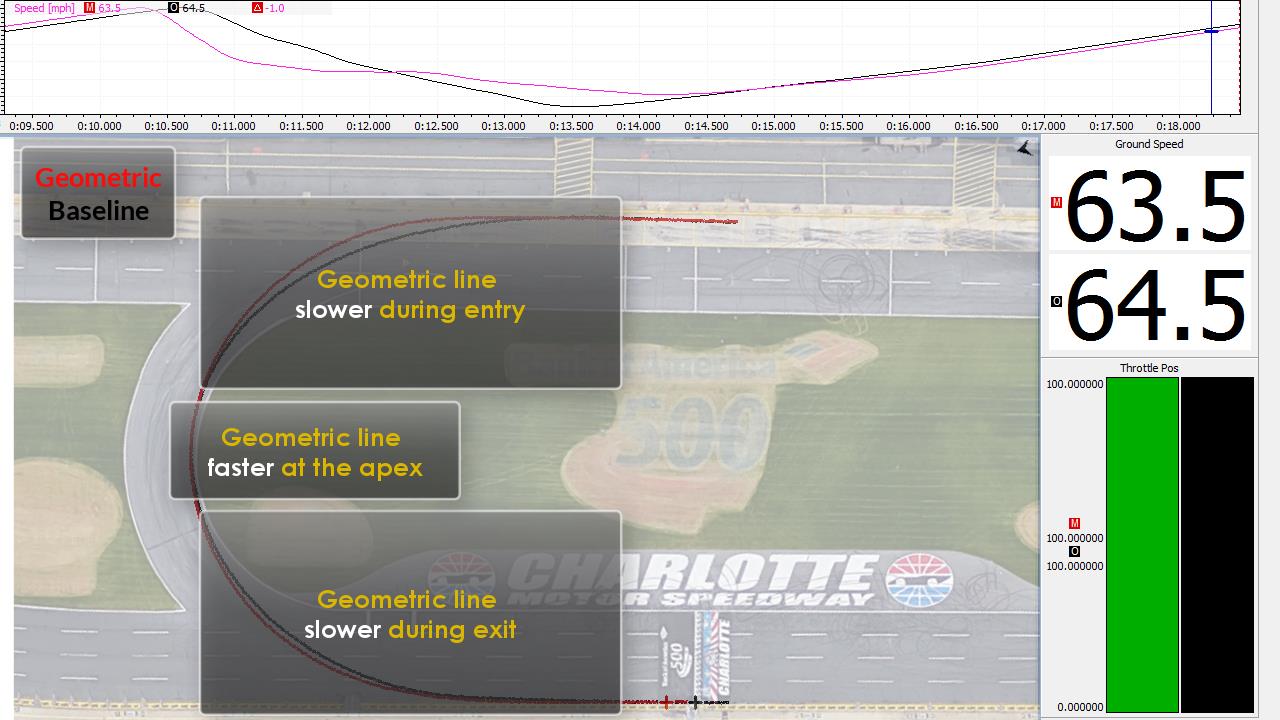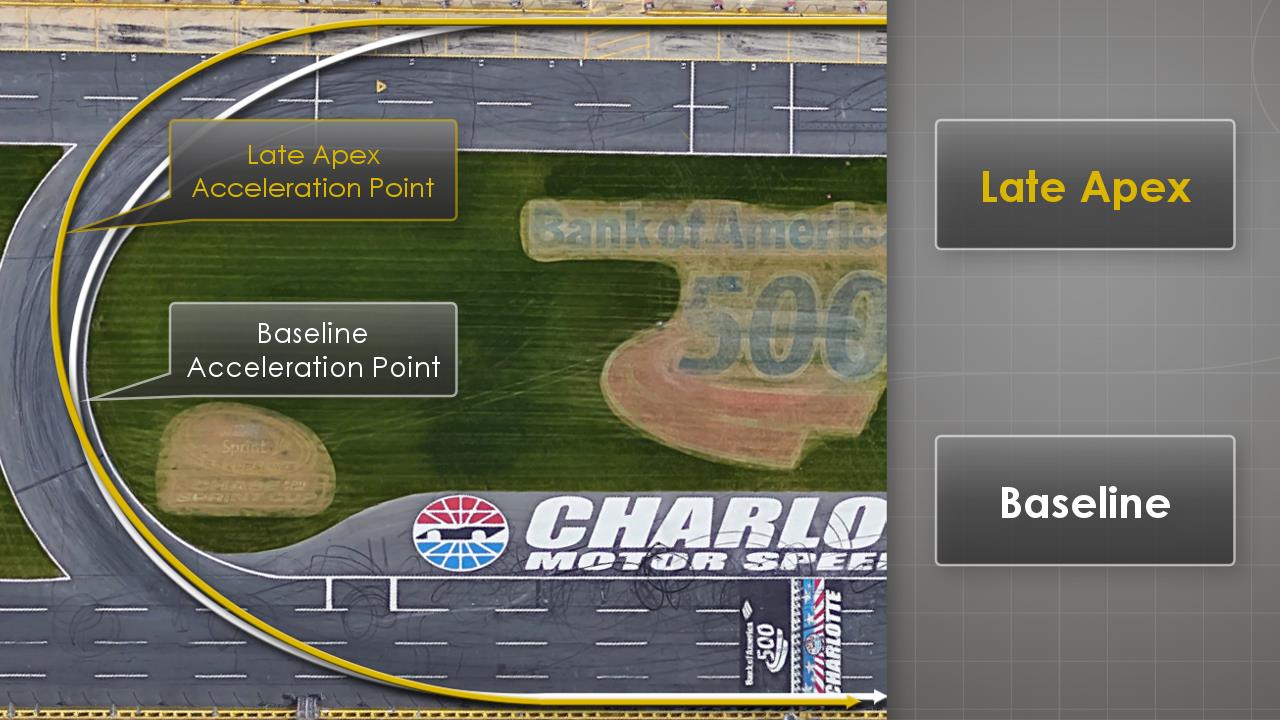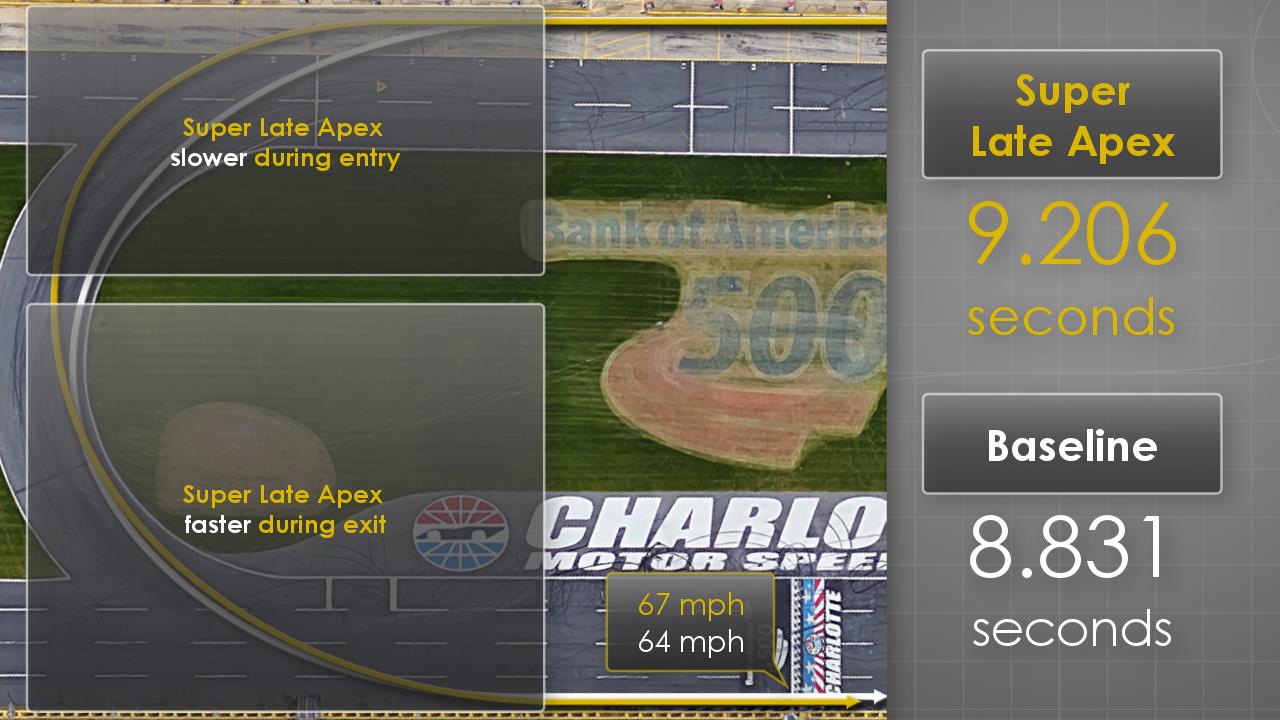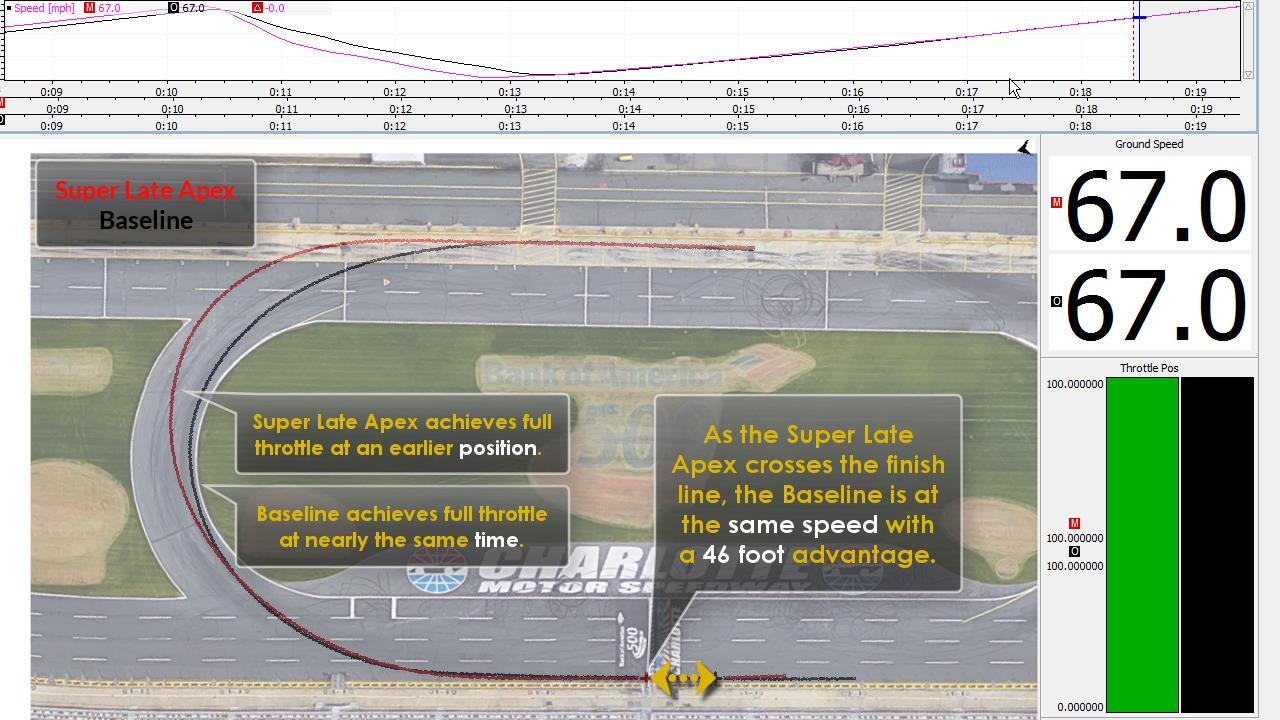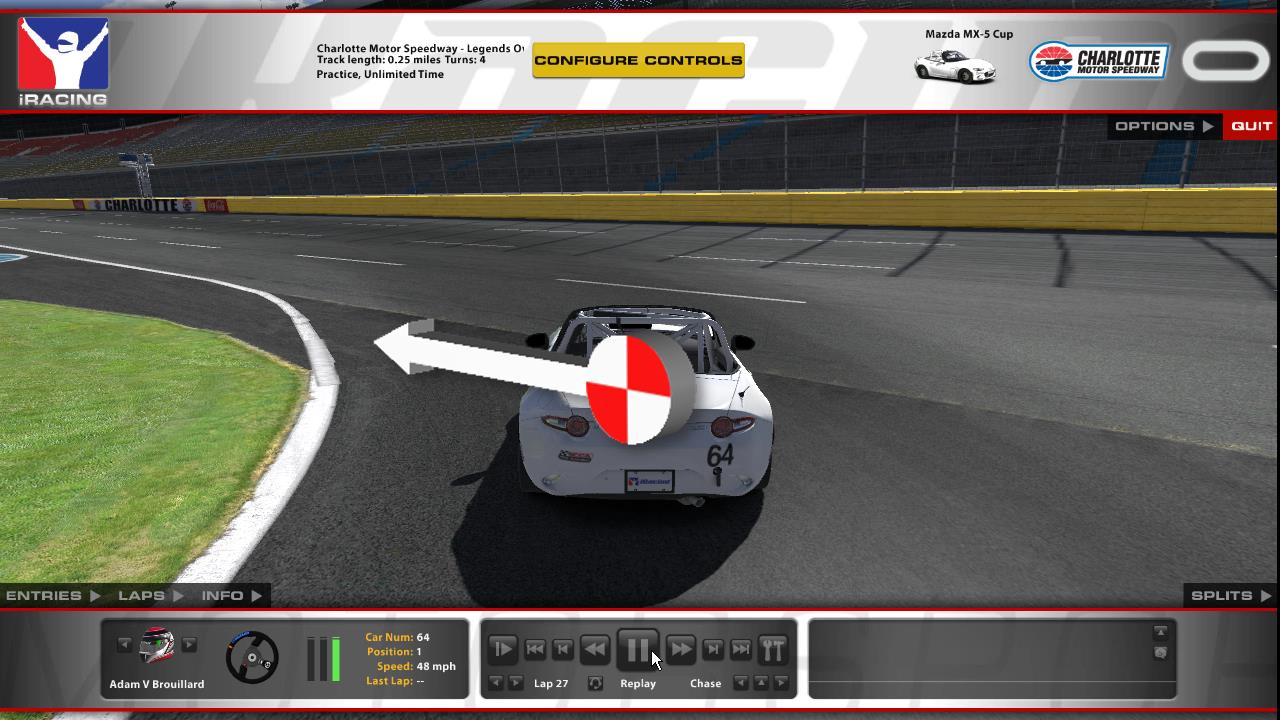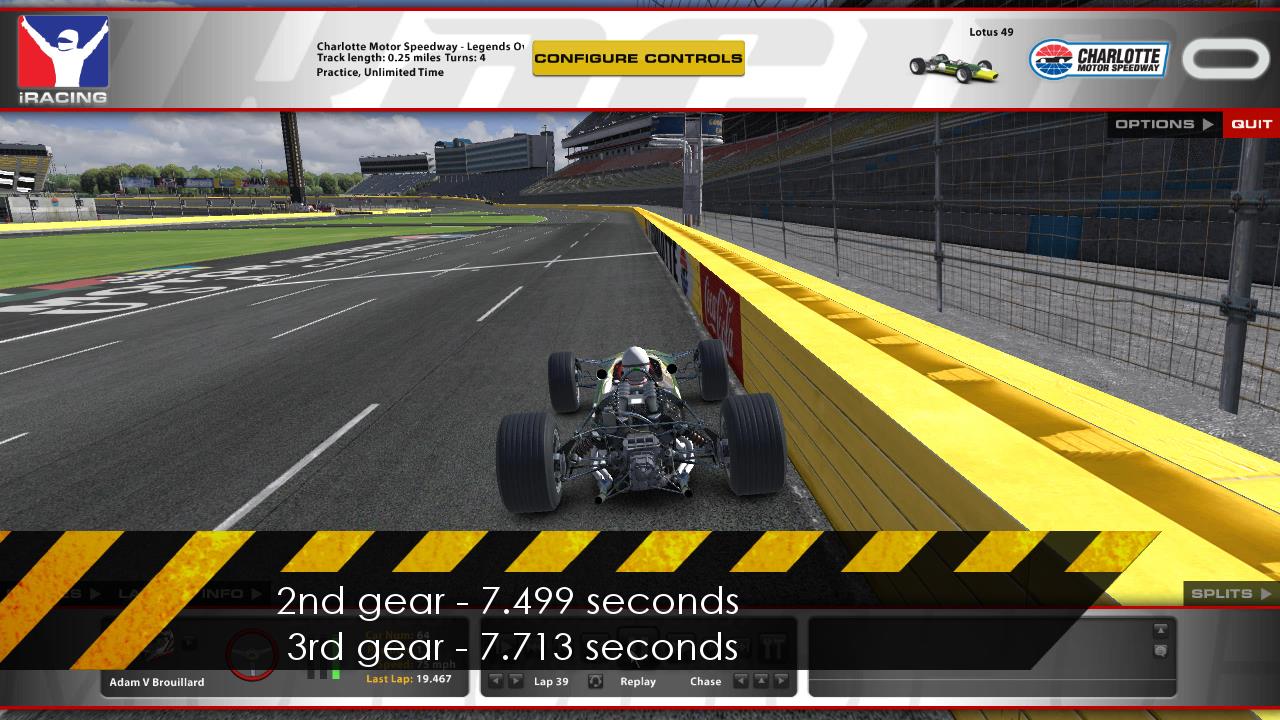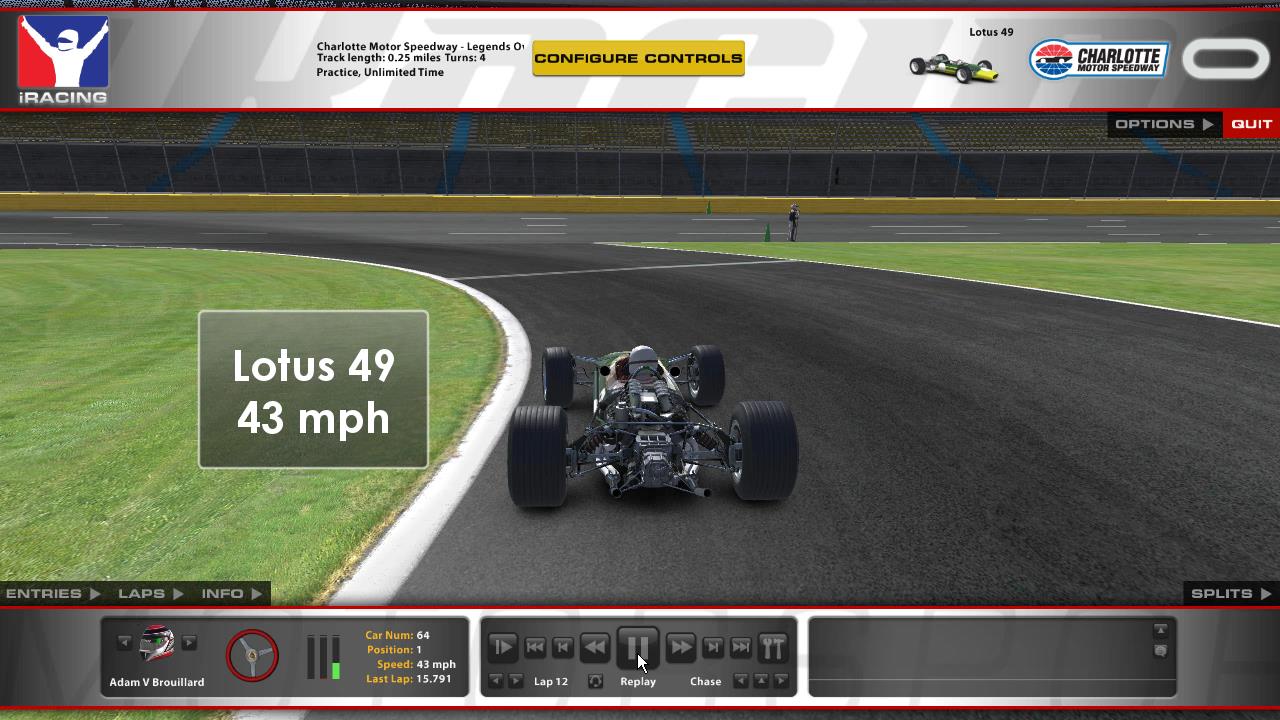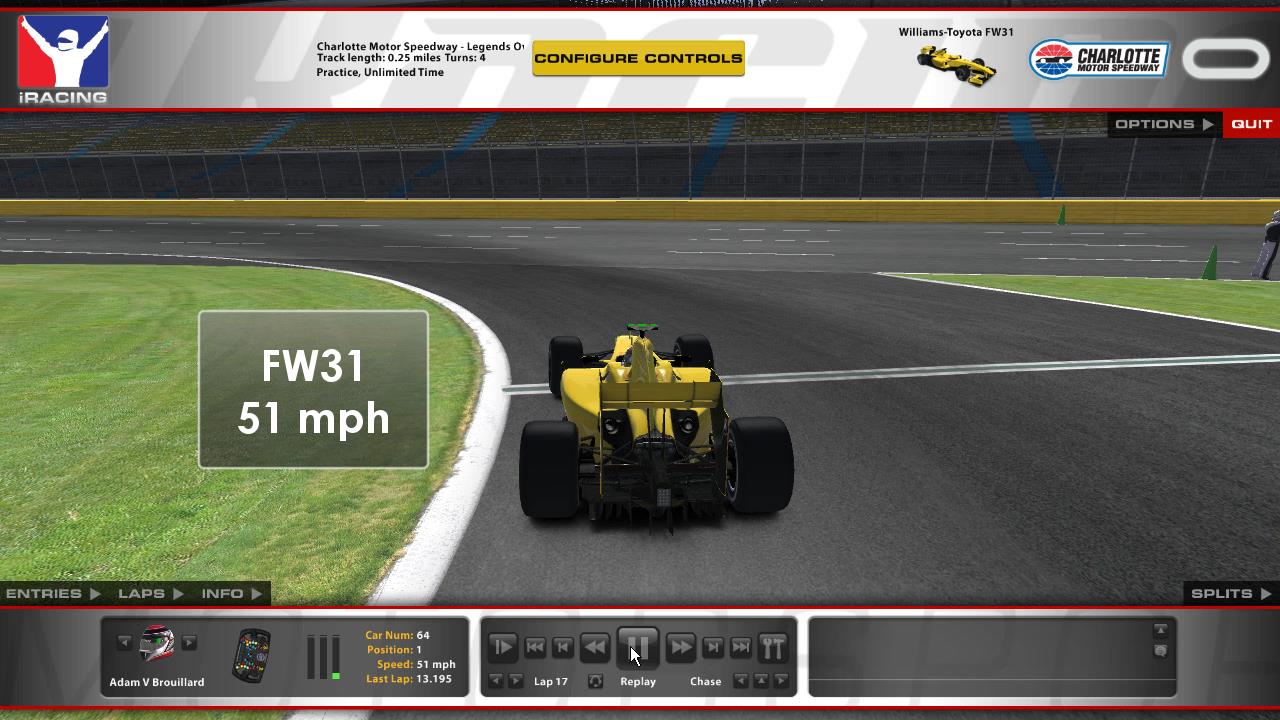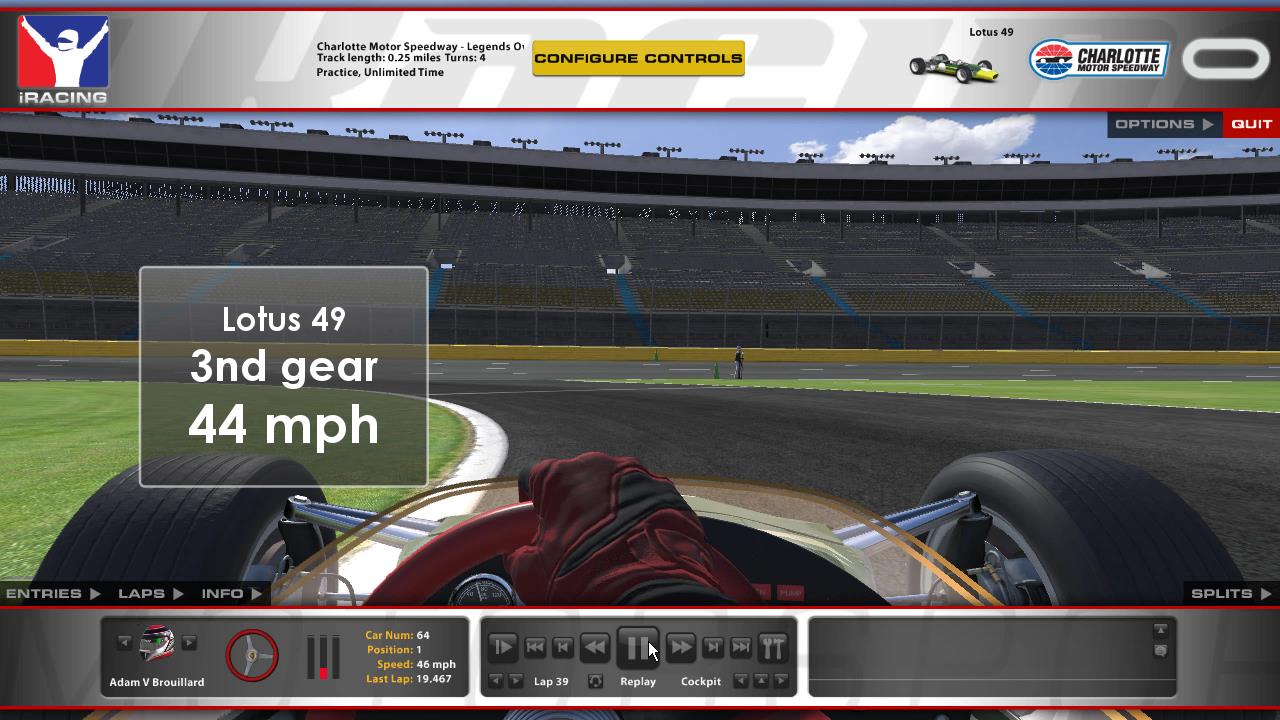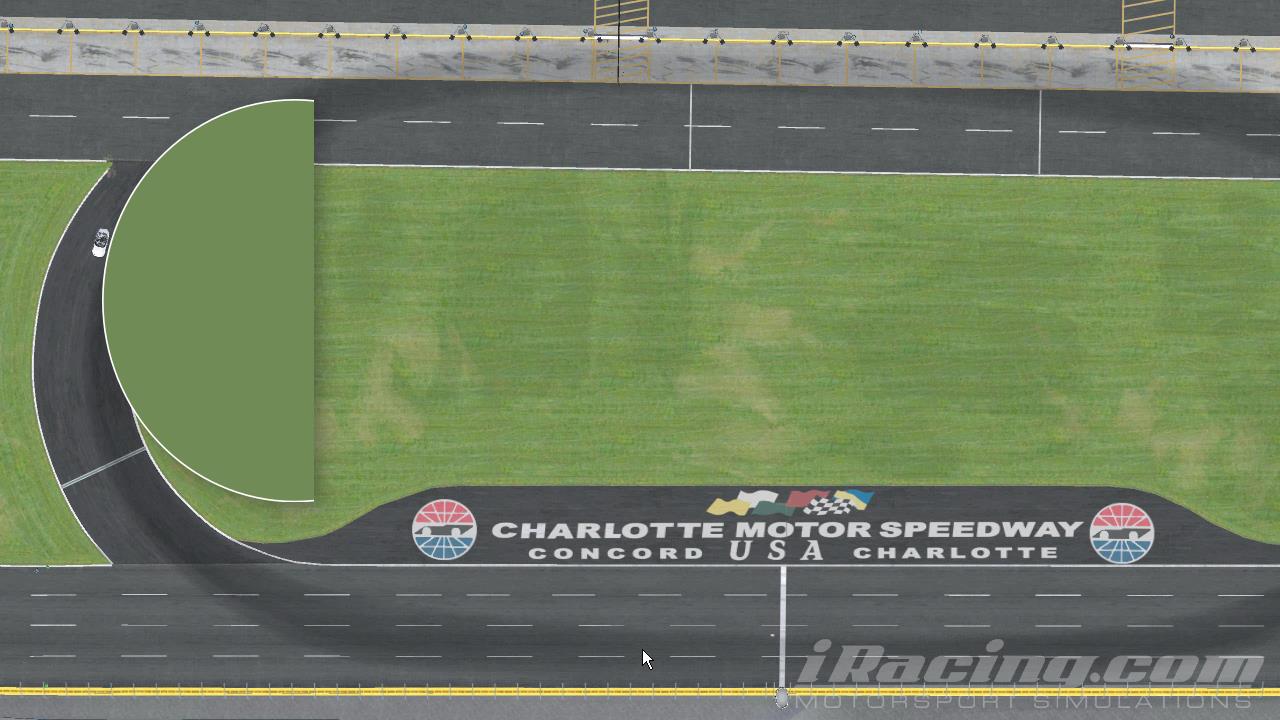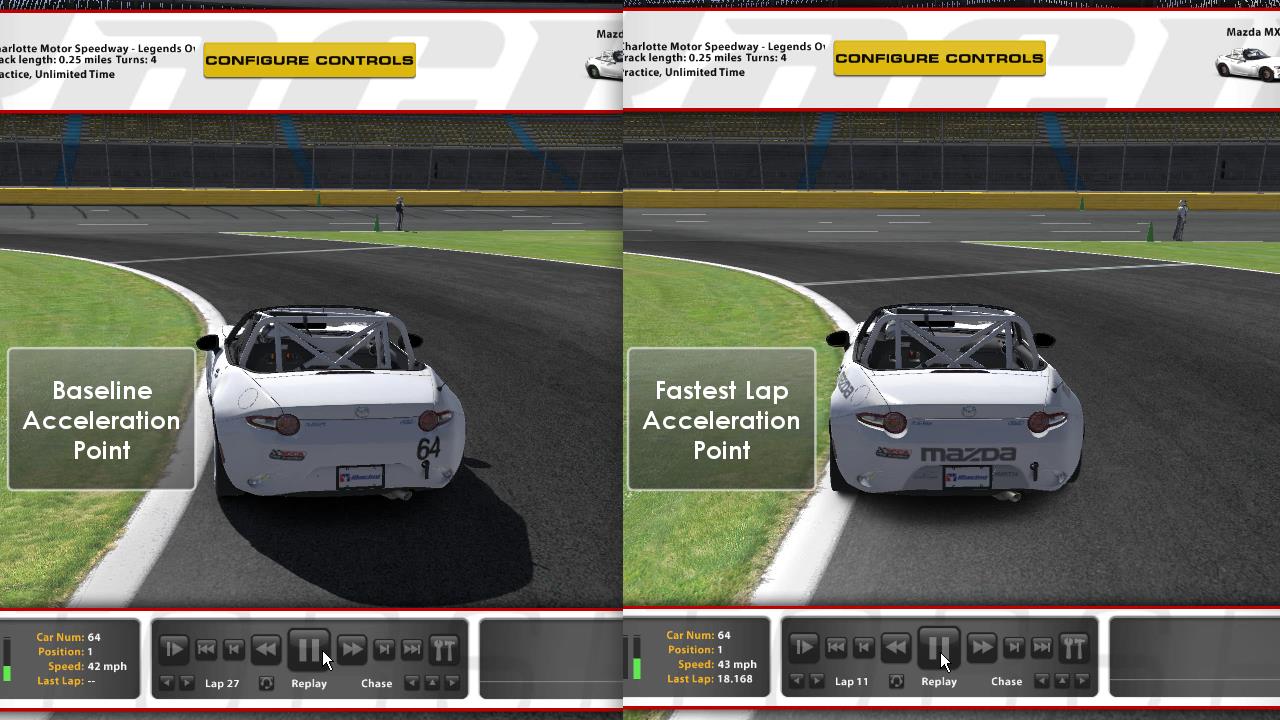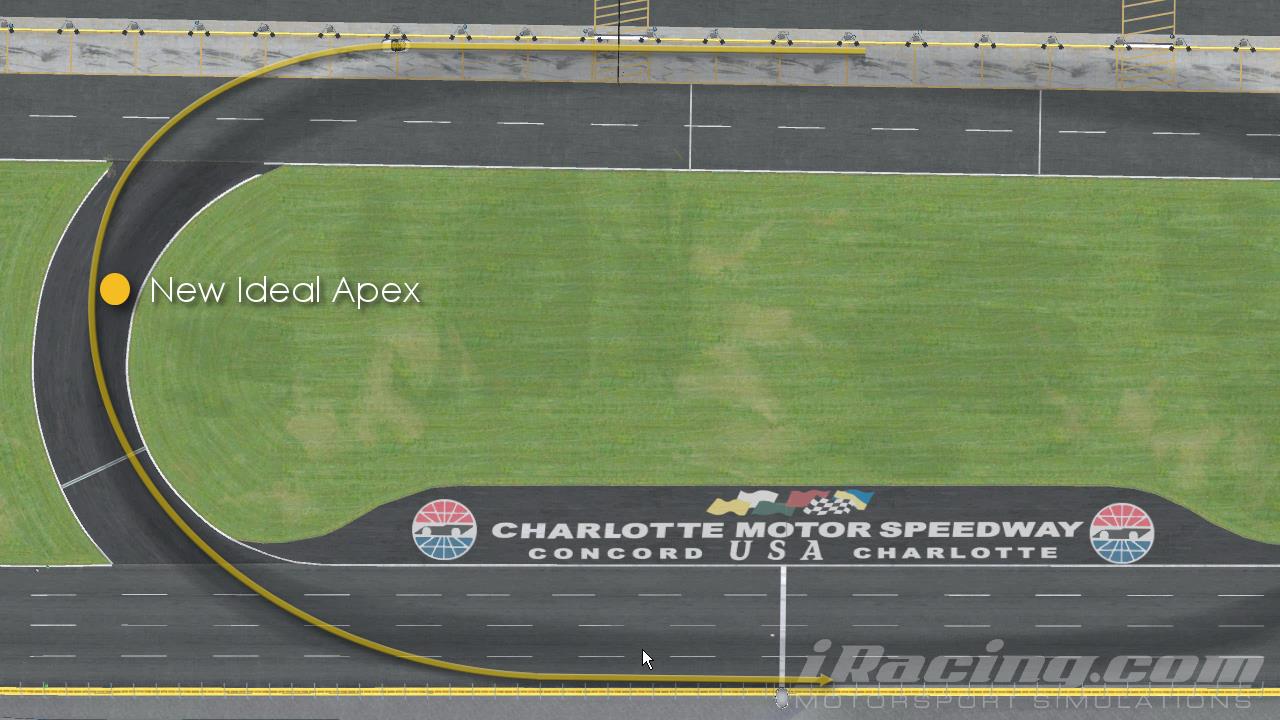In this video, author Adam Brouillard discusses the physics of the racing line.
Topics covered include:
- The Geometric Line
- The Late Apex
- The Corner Entry Spiral
- Corner Exit Acceleration
- Using the Whole Track
- Driving at the Limit
- Driver Training
- The Geometric Line
- The Late Apex
- The Corner Entry Spiral
- Corner Exit Acceleration
- Using the Whole Track
- Driving at the Limit
- Driver Training
Transcript
Introduction
My name is Adam Brouillard. I am head instructor for Paradigm Shift Driver Development and author of the Science of Speed Series books. We are going to be looking at the physics of the racing line. We’ll first go over some different types of cornering techniques and then identify the four main elements of a perfect corner. Next we’ll learn to use these elements to work up a corner and identify mistakes. Finally we’ll end by looking at a training exercise designed to improve your overall driving ability.
We are going to be analyzing different techniques so first we need to establish a good testbed to make comparisons. The Charlotte Legends track in iRacing is great for our purposes for a few reasons. It consists of just two, flat nearly identical 180 degree corners and they are separated into one sector each. This allows us to easily isolate just a single corner to get some feedback as to how our different techniques affect the exact time it takes to complete a standard corner.
Introduction
My name is Adam Brouillard. I am head instructor for Paradigm Shift Driver Development and author of the Science of Speed Series books. We are going to be looking at the physics of the racing line. We’ll first go over some different types of cornering techniques and then identify the four main elements of a perfect corner. Next we’ll learn to use these elements to work up a corner and identify mistakes. Finally we’ll end by looking at a training exercise designed to improve your overall driving ability.
We are going to be analyzing different techniques so first we need to establish a good testbed to make comparisons. The Charlotte Legends track in iRacing is great for our purposes for a few reasons. It consists of just two, flat nearly identical 180 degree corners and they are separated into one sector each. This allows us to easily isolate just a single corner to get some feedback as to how our different techniques affect the exact time it takes to complete a standard corner.
Plus the corners take nearly 10 seconds to get through, which is very long for a standard corner. A mistake that might cost you a 10th of a second in an average length corner will cost you significantly more here so variations in performance will be easier to see. The primary vehicle we are going to be using is the Global Mazda MX-5, which is a relatively low-powered car. Both the car and track are also part of the base iRacing content so even with just a trial subscription I encourage you to follow along with these exercises. We are going to be using the default weather and car setup for all laps.
Let’s start by setting a baseline corner to which we can make comparisons. The fastest lap for this combination that I happen to have a replay of is a 17.527. The second corner’s sector time is 8.799 and this is the corner we will focus on. Unfortunately, I didn’t record any telemetry for that lap so I’ve also done a quick session to grab some and the best I did in our testbed corner was an 8.831 which is about 3 hundredths of a second slower. This will make a good baseline from which we can make comparisons and it also allows us an opportunity to identify some mistakes later on.
Beyond just looking at the time, let’s note a few things that happen in the corner. The minimum speed reached is about 42 mph and this happens near the inside of the track at the apex right as I go to full power. I also reach 64 mph as I cross the start/finish line. I did this baseline corner and I will be doing all comparison corners on the out lap so that the tires are always the same temperature and condition as we enter the corner. This way the only variations that will affect our time is driving technique.
Let’s start by setting a baseline corner to which we can make comparisons. The fastest lap for this combination that I happen to have a replay of is a 17.527. The second corner’s sector time is 8.799 and this is the corner we will focus on. Unfortunately, I didn’t record any telemetry for that lap so I’ve also done a quick session to grab some and the best I did in our testbed corner was an 8.831 which is about 3 hundredths of a second slower. This will make a good baseline from which we can make comparisons and it also allows us an opportunity to identify some mistakes later on.
Beyond just looking at the time, let’s note a few things that happen in the corner. The minimum speed reached is about 42 mph and this happens near the inside of the track at the apex right as I go to full power. I also reach 64 mph as I cross the start/finish line. I did this baseline corner and I will be doing all comparison corners on the out lap so that the tires are always the same temperature and condition as we enter the corner. This way the only variations that will affect our time is driving technique.
The Geometric Line
For our first comparison, let’s take a look at the classic geometric line. The geometric line is the widest arc we can take through a corner and is driven at near constant speed. It’s often stated that this is the fastest way through just a single corner when we aren’t worried about maximizing exit speed for a following straightaway. Let’s put this idea to the test in our isolated corner and see what we come up with.
For our first comparison, let’s take a look at the classic geometric line. The geometric line is the widest arc we can take through a corner and is driven at near constant speed. It’s often stated that this is the fastest way through just a single corner when we aren’t worried about maximizing exit speed for a following straightaway. Let’s put this idea to the test in our isolated corner and see what we come up with.

I was able to increase the minimum speed through the corner by 4 mph to a slowest of 46 at the apex. I also started the corner about 1 mph faster than our baseline and the speed at the end of the corner as we cross the finish line is the same as the baseline at 64 mph.
So we lost less speed in the corner, we ended at the same speed and started slightly faster. So It seems that this might really be the fastest way through an isolated corner, but if we look at our sector time, it took 9 seconds to complete the corner which is almost 2 tenths of a second slower than our baseline.
Let’s load up the telemetry so we can take a closer look at this comparison.
So we lost less speed in the corner, we ended at the same speed and started slightly faster. So It seems that this might really be the fastest way through an isolated corner, but if we look at our sector time, it took 9 seconds to complete the corner which is almost 2 tenths of a second slower than our baseline.
Let’s load up the telemetry so we can take a closer look at this comparison.
While the lines look pretty similar you can see that the geometric line is not only slightly longer than the baseline, but more importantly, in order to maintain a higher minimum speed at the apex, the geometric line is slower primarily during the entry, but also during the exit of the corner.
Shortly, we’ll come back to this and look at it from a physics perspective to understand what it is about the geometric line that makes it slower, but right now we want to point out an important lesson from this. To evaluate the usefulness of a racing line, you have to look beyond just the speed achieved at any certain places on the track. While the individual speeds in our geometric line seemed faster, the time through the corner was actually slower, and time is what matters on a racetrack.
The Late Apex
For our next comparison, we’re going to examine the late apex. While an ideal apex is almost always later in a corner than the geometric apex, what we are actually referring to here is the technique of tightening up the radius at the entrance of a corner so that you can accelerate earlier. The key difference from our baseline is that the acceleration point is before your line reaches the inside of the track.
Shortly, we’ll come back to this and look at it from a physics perspective to understand what it is about the geometric line that makes it slower, but right now we want to point out an important lesson from this. To evaluate the usefulness of a racing line, you have to look beyond just the speed achieved at any certain places on the track. While the individual speeds in our geometric line seemed faster, the time through the corner was actually slower, and time is what matters on a racetrack.
The Late Apex
For our next comparison, we’re going to examine the late apex. While an ideal apex is almost always later in a corner than the geometric apex, what we are actually referring to here is the technique of tightening up the radius at the entrance of a corner so that you can accelerate earlier. The key difference from our baseline is that the acceleration point is before your line reaches the inside of the track.
The strategy being that the time lost during corner entry is more than made up for by the extra speed that is carried down a long straightaway. So as not to confuse this approach with discussion of simply adjusting your acceleration point to a later apex along the inside of the track, we often refer to this method as the super late apex.
Looking at the super late apex line, we can see that I’ve tightened up the radius at the entrance to the corner so that we can accelerate earlier. I did this while still maintaining a minimum speed of 41, which is only 1 mph slower than our baseline. But this has allowed me to increase the speed as we cross the start/finish line by 3 mph up to 67. Looking at the line from overhead we can see how the profile matches the illustrations depicting this technique. Our time through the corner is 9.2 seconds, which is slower than our baseline, but this was to be expected as we compromised the entrance. The strategy however, is that if we have a long enough straight afterwards that 3 mph advantage will make up the difference and then some. So let’s look at the telemetry to see how long the straight would have to be for this strategy to be viable.
While the super late apex car is able to achieve full throttle at an early position in the corner, both cars achieve full throttle at nearly the same point in time. So while the super late apex car has reached 67 and is going 3 mph faster at the same position on track that they cross the start/finish. At the same point in time, the baseline car already has a several car length advantage and has also reached the same speed of 67 mph. So regardless of the length of the straight, a super late apex line will never make up the difference. The baseline method will always be faster. We’ll look at the physics behind this shortly, but as in the geometric line, the principle that we’re learning here is that your speed at any certain position in a corner is not important, only the amount of time it takes to achieve that speed. Again, time is what matters on a racetrack.
The Perfect Corner
Let’s take a step back now so we can look at our corner from a physics perspective. We’ll see if we can identify the problems with our two alternate lines and what exactly it means to drive a perfect corner.
Every standard corner can be broken down into three basic obstacles. The corner entry edge, the corner exit edge, and the most limiting point along the inside of the track, which we will simply call the apex. To navigate these obstacles in the minimum time possible, a driver must maximize the force the vehicle can generate decelerating it in the same direction as the corner entry edge and then accelerating it in the same direction as the corner exit edge.
The Perfect Corner
Let’s take a step back now so we can look at our corner from a physics perspective. We’ll see if we can identify the problems with our two alternate lines and what exactly it means to drive a perfect corner.
Every standard corner can be broken down into three basic obstacles. The corner entry edge, the corner exit edge, and the most limiting point along the inside of the track, which we will simply call the apex. To navigate these obstacles in the minimum time possible, a driver must maximize the force the vehicle can generate decelerating it in the same direction as the corner entry edge and then accelerating it in the same direction as the corner exit edge.
As the angle of a corner changes, the ideal directions of force will simply follow the outside track edges
So at the apex of our test bed corner, our goal is not to accelerate the car forward as quickly as possible. From the very instant we cross the apex all the way to the track edge, our actual goal is to best use all four tires to constantly maximize the acceleration of the car’s center of gravity in the same direction as the corner exit edge. Likewise, from the braking point all the way to the apex we should maximize our tire forces decelerating the car in a direction which parallels the entry edge. The greater the total net force produced in the ideal directions, the lower the time will be through the corner.
A driver has more to go on that just the basic physics alone however. If you are successful in maximizing force in the ideal directions, four primary things will happen. We call these the four elements of a perfect corner. You will be able to use these to work up a corner and identify your mistakes. These four elements apply to all corners, but advanced combinations such as chicanes and double apexes will require some additional elements to optimize correctly. So let’s go through the four elements one by one in increasing order of how important they are to achieving a good lap time.
A driver has more to go on that just the basic physics alone however. If you are successful in maximizing force in the ideal directions, four primary things will happen. We call these the four elements of a perfect corner. You will be able to use these to work up a corner and identify your mistakes. These four elements apply to all corners, but advanced combinations such as chicanes and double apexes will require some additional elements to optimize correctly. So let’s go through the four elements one by one in increasing order of how important they are to achieving a good lap time.
#4 The Corner Entry Spiral
Starting at number 4 we have the corner entry spiral. During corner entry, your line should have a smooth, spiral shape from the edge of the track to the apex. The vehicle’s path will steadily become tighter and it will lose speed from the braking point all the way to your acceleration point.
Starting at number 4 we have the corner entry spiral. During corner entry, your line should have a smooth, spiral shape from the edge of the track to the apex. The vehicle’s path will steadily become tighter and it will lose speed from the braking point all the way to your acceleration point.
In comparison, our geometric line is much more circular shaped and so the speed and steering position remain mostly unchanging well before the apex.
If we look at the speed traces, you can see the baseline with a distinct slope whereas the geometric line’s deceleration rate is inconsistent. Remember, both of these were driven at the limit for the entire corner, the only difference was the direction of the tire forces acting on the vehicle.

To achieve this spiral shaped entry will require trailbraking for the vast majority of cars, but this not always the case. The goal is to maximize the tire force pushing the vehicle's center of gravity in the ideal direction so a driver must work out how each car makes its best grip.
In a rally car for example, a typical trailbraking maneuver generates poor grip at certain angles and so off-road driving will typically require other techniques such as hand brake turns or Scandinavian flicks to spiral to the apex and decelerate efficiently.
From a laptime perspective however, a spiral shaped corner entry is the least important of the four elements. While it is the fastest way if done properly, trail braking can be very difficult in certain situations whereas arriving at the apex with the correct momentum is critical for a good laptime. A driver that takes a more constant speed , but easier to drive entry will usually only lose a 10th of second at most per corner if their corner exit is ideal. When a driver is looking for that last little bit of time however, corner entry is usually where they will find it.
In a rally car for example, a typical trailbraking maneuver generates poor grip at certain angles and so off-road driving will typically require other techniques such as hand brake turns or Scandinavian flicks to spiral to the apex and decelerate efficiently.
From a laptime perspective however, a spiral shaped corner entry is the least important of the four elements. While it is the fastest way if done properly, trail braking can be very difficult in certain situations whereas arriving at the apex with the correct momentum is critical for a good laptime. A driver that takes a more constant speed , but easier to drive entry will usually only lose a 10th of second at most per corner if their corner exit is ideal. When a driver is looking for that last little bit of time however, corner entry is usually where they will find it.
#3 Maximum Acceleration
Arriving at the apex with the correct momentum is critical because only the correct amount will allow us to maximize acceleration. Too much or too little momentum will compromise our corner exit.
Let’s take a look at our geometric line again. At the apex, we have a speed of 46 mph, but at that very moment the only thing that 46 mph is doing is sending us directly toward the wall. Our goal however is to accelerate as quickly as possible in the same direction as the exit edge. In this case, we actually have too much momentum and you can see this evidenced as not being able to apply full throttle until much later in the corner.
This hurts our exit because now we must use some of the tire force that could be used to accelerate us in the ideal direction to counteract our excessive momentum. If instead, we had too little momentum at the apex, although we would be able to achieve full throttle right away, our corner exit would still be slower than ideal. We wouldn’t need to use the entire track during corner exit, which means the total tire force generated to accelerate us in the ideal direction was compromised.
If we draw arrows showing the direction the tires are pushing the car throughout the geometric line you’ll notice how they point inward. Much of the tire force generated during the corner entry is then simply cancelled out during the corner exit. This is wasted force and is the reason the geometric line is slower.
Arriving at the apex with the correct momentum is critical because only the correct amount will allow us to maximize acceleration. Too much or too little momentum will compromise our corner exit.
Let’s take a look at our geometric line again. At the apex, we have a speed of 46 mph, but at that very moment the only thing that 46 mph is doing is sending us directly toward the wall. Our goal however is to accelerate as quickly as possible in the same direction as the exit edge. In this case, we actually have too much momentum and you can see this evidenced as not being able to apply full throttle until much later in the corner.
This hurts our exit because now we must use some of the tire force that could be used to accelerate us in the ideal direction to counteract our excessive momentum. If instead, we had too little momentum at the apex, although we would be able to achieve full throttle right away, our corner exit would still be slower than ideal. We wouldn’t need to use the entire track during corner exit, which means the total tire force generated to accelerate us in the ideal direction was compromised.
If we draw arrows showing the direction the tires are pushing the car throughout the geometric line you’ll notice how they point inward. Much of the tire force generated during the corner entry is then simply cancelled out during the corner exit. This is wasted force and is the reason the geometric line is slower.
Comparatively, in an ideal line as much tire force as possible is used to decelerate and then accelerate the car.
Maximum acceleration does not always mean full throttle however. Let’s take a different car through the corner, the Lotus 49, which has a similar amount of grip as the MX-5, but significantly more power. This time, we aren’t able to reach full throttle at the apex without excessive wheelspin. As a general rule, to maximize acceleration, if you can’t achieve full throttle at the apex you shouldn’t be able too until you are going nearly straight. Instead you will apply progressive power as you steadily reduce steering.
It’s important to realize that progressive power doesn’t necessarily mean progressive throttle though, it depends on the shape of the car’s powerband. In the Lotus, power climbs quickly with rpm so even though it looks like we are very near full throttle for the entire exit, the power going to the wheels is actually increasing progressively.
It’s important to realize that progressive power doesn’t necessarily mean progressive throttle though, it depends on the shape of the car’s powerband. In the Lotus, power climbs quickly with rpm so even though it looks like we are very near full throttle for the entire exit, the power going to the wheels is actually increasing progressively.
Whether to apply full or progressive power not only depends on the car, but also the corner. For example, the Lotus in a faster corner would be in a higher gear and so wouldn’t be able to accelerate as quickly.
So Let’s now take the Lotus through our same corner in 3rd gear instead of 2nd so we have the exact same level of grip, but less acceleration potential and we’ll see how this affects our apex and exit. Just as in the MX-5, we are now able to reach full throttle right at the apex without excessive wheelspin. But in 3rd gear, we needed more momentum to optimize the exit. Our minimum apex speed is now 44 up from the previous 43, but the higher gear reduced our acceleration potential and so our time through the corner is slower by about 2 tenths
So Let’s now take the Lotus through our same corner in 3rd gear instead of 2nd so we have the exact same level of grip, but less acceleration potential and we’ll see how this affects our apex and exit. Just as in the MX-5, we are now able to reach full throttle right at the apex without excessive wheelspin. But in 3rd gear, we needed more momentum to optimize the exit. Our minimum apex speed is now 44 up from the previous 43, but the higher gear reduced our acceleration potential and so our time through the corner is slower by about 2 tenths
So in all corners, every different car will have a certain amount of momentum, a perfect apex, that is required to maximize the force pushing it in the ideal direction.
For a given level of grip, more power will need a slower apex and less power will need a faster apex, or put another way, if you have you less power, you need more momentum to maximize acceleration in the ideal direction. This is why lower powered cars are often referred to as momentum cars.
#2 Use the Whole Track
Our second most important element of a perfect corner is that we must use the whole track. Often, one of the first things that a novice learns, there is a bit more to this than going from the outside, to the inside and then back to the outside of the track.
Let’s look again at our super late apex line. The biggest problem with this line and why it is almost 4/10ths slower than our baseline is that we did not even come close to using the whole track. While it looks like we go from the outside to the inside and then all the way back out, the point we cross the inside of the track is not really an apex.
Our second most important element of a perfect corner is that we must use the whole track. Often, one of the first things that a novice learns, there is a bit more to this than going from the outside, to the inside and then back to the outside of the track.
Let’s look again at our super late apex line. The biggest problem with this line and why it is almost 4/10ths slower than our baseline is that we did not even come close to using the whole track. While it looks like we go from the outside to the inside and then all the way back out, the point we cross the inside of the track is not really an apex.
By accelerating much earlier, we have actually created what we call a false apex out in the middle of the track. We are essentially optimizing the corner around an obstacle that is not really there. This has effectively made the track much narrower than it really is. This is why the acceleration point should ideally be at the most limiting point along the inside of the track. If it is not, then you aren’t using as much track as you could be.
This does not mean that a driver should simply wait to apply throttle as they pass the inside of the track however. In the baseline lap you can see that where I begin accelerating is actually slightly before where it could be if I had used every last bit of the track during corner entry. This indicated to me that my approach wasn’t quite optimal, but if I had waited any longer to apply throttle, I would have made the laptime penalty for the error even worse. This is because, no matter where a driver is in a corner, they should begin maximum acceleration the very instant that it will take them to the edge of track at corner exit. If I had delayed acceleration any longer, I would have used even less of the track than I already was.
Driving a track is a dynamic process. A good driver will constantly be creating a new optimal line based on their current situation. I like to say, never give up on a corner. No matter how bad you feel you have messed up a corner so far, you can always optimize the rest from that moment on. For example, if I had not driven the super late apex line on purpose and I instead had just severely missed my braking point, the super late apex line would no longer be a bad strategy, it would then be correct. The instant I realized that I went too deep, I would need to create a new optimal line for the false apex I had just accidentally created.
Optimizing a corner is all about constantly recognizing and correcting mistakes. Ideally catching them quickly before they become big mistakes. If you ever think you just drove a mistake free corner, it just means you haven’t developed the sensitivity yet to recognize the 100 smaller mistakes you actually just made.
Optimizing a corner is all about constantly recognizing and correcting mistakes. Ideally catching them quickly before they become big mistakes. If you ever think you just drove a mistake free corner, it just means you haven’t developed the sensitivity yet to recognize the 100 smaller mistakes you actually just made.
#1 Find the Limit (The Universal Cue)
So in the baseline corner, we’ve seen that I started accelerating a bit early so that I could at least optimize the rest of the corner by using the whole track during my exit. But if we now look at my corner exit, I didn’t quite use as much of the track as I had done in my other comparison laps. So why didn’t I go all the way out to the wall as I was planning to? The reason is because of the most important element of a perfect corner. Driving all the way out to the wall would have dropped me below the limit and so I wouldn’t be maximizing the total force accelerating me in the ideal direction. Which after all, is the ultimate goal of all of this.
So in the baseline corner, we’ve seen that I started accelerating a bit early so that I could at least optimize the rest of the corner by using the whole track during my exit. But if we now look at my corner exit, I didn’t quite use as much of the track as I had done in my other comparison laps. So why didn’t I go all the way out to the wall as I was planning to? The reason is because of the most important element of a perfect corner. Driving all the way out to the wall would have dropped me below the limit and so I wouldn’t be maximizing the total force accelerating me in the ideal direction. Which after all, is the ultimate goal of all of this.
Driving at the limit is not just about using your tires to their absolute maximum though; it’s also about directing those tire forces in the right direction, at the right time Let’s look again at our geometric line. My goal was to drive the corner at the maximum limit of the tires, but I was intentionally directing all of that force sideways in relation to the car for the whole corner. During our faster baseline corner however, my goal was not just to drive at limit of the tires. I needed to be aware of my angle, speed and position at all times because I needed to direct those tire forces in relation to the track, not the car. Developing a sensitivity to how these forces affect the car’s overall movement through a corner can allow a precision in your driving that no other car control cue can match. If you learn to develop this cue properly, it can absolutely transform your driving. While some drivers just do this naturally, in others it must be trained. We call this sensitivity to the overall movement of a vehicle the Universal Cue.
The Universal Cue is different from most other car control cues in that your primary focus is not on things within the car such as listening to the tires or the feeling you get through the steering wheel. Instead, it is about paying attention to how your driver inputs affect the car’s overall movement through a corner. You aren’t focusing on the car to drive at the limit, you’re focusing on the track. During my baseline corner for example, as I approached the apex, my focus was simply on moving the car across the finish line as quickly as possible. This is what guided my driver inputs and let me know to go to full throttle early and not drive all the way out to the wall.
Likewise, In the Lotus, although my goal and focus were the same, the driver inputs turned out quite different. Paying attention to the Universal Cue showed me how much throttle and steering to give at every instant to maximize my movement toward the finish line. Conversely, if I’m training in a rally sim, maximizing movement down the track typically requires very high slip angles and large amounts of wheelspin that would be very slow on tarmac. So even though these cars might all accomplish it in a different way, a driver must work out how to maximize the force they can generate in each one.
While all the other car control cues are helpful and can get you close, only learning to pay attention to the overall movement of a vehicle through a corner will give you the final answer to where that last little bit of time hides. This is because the Universal Cue is simply the direct representation of the physics used to optimize a racing line. So while the Universal Cue guides your inputs, you can then use the other elements to identify how to modify your approach to bring you ever closer to the perfect corner. Of course, no one will never truly get there because while we can understand in our minds what it takes to drive the perfect corner, performance will always be limited by how well someone can control the car, and car control ability has no upper limit.
The Universal Cue is different from most other car control cues in that your primary focus is not on things within the car such as listening to the tires or the feeling you get through the steering wheel. Instead, it is about paying attention to how your driver inputs affect the car’s overall movement through a corner. You aren’t focusing on the car to drive at the limit, you’re focusing on the track. During my baseline corner for example, as I approached the apex, my focus was simply on moving the car across the finish line as quickly as possible. This is what guided my driver inputs and let me know to go to full throttle early and not drive all the way out to the wall.
Likewise, In the Lotus, although my goal and focus were the same, the driver inputs turned out quite different. Paying attention to the Universal Cue showed me how much throttle and steering to give at every instant to maximize my movement toward the finish line. Conversely, if I’m training in a rally sim, maximizing movement down the track typically requires very high slip angles and large amounts of wheelspin that would be very slow on tarmac. So even though these cars might all accomplish it in a different way, a driver must work out how to maximize the force they can generate in each one.
While all the other car control cues are helpful and can get you close, only learning to pay attention to the overall movement of a vehicle through a corner will give you the final answer to where that last little bit of time hides. This is because the Universal Cue is simply the direct representation of the physics used to optimize a racing line. So while the Universal Cue guides your inputs, you can then use the other elements to identify how to modify your approach to bring you ever closer to the perfect corner. Of course, no one will never truly get there because while we can understand in our minds what it takes to drive the perfect corner, performance will always be limited by how well someone can control the car, and car control ability has no upper limit.
Driver Training
This brings us to driver training. While learning the four elements is the first step, training them properly is how you will take your driving to the next level. There are dozens of different training exercises we use to work on a driver’s different skills, but one we find the most useful is directly related to what we’ve been discussing.
In this exercise, what you will do is find a way to isolate and time a single corner. Practically any sim, car, and track can be used, but the MX-5 at Charlotte Legends is a great and easy to set up training combo to start with. You will then turn off any live sector time display and run the lap multiple times. Each time you complete the corner you will predict whether that was your best time so far. If you believe it was you will stop and check whether or not you are correct. This will force you to constantly self-analyze your performance as you drive. Rather than seeing a new low sector time flash up on screen and then going back to try to figure out what you did differently that time, you will instead be learning to predict what elements of your driving create that low time. It’s a subtle, but very powerful difference.
What you are actually training here is your sensitivity to the Universal Cue. Being able to accurately predict that you just did your lowest time means you are beginning to recognize when you’ve best maximized your tire forces moving you in the ideal directions. As we’ve learned, how well these forces have been maximized and directed is the only thing that truly determines your time.
This is not only about sensing when you did your best time however, it’s about being able to identify mistakes and how much they cost you. Highly trained drivers can often predict their sector times to within a 20th of a second. It’s very important for this exercise that the only variable be the driver. Any change in sector time should be caused by something the driver did, not by a change in weather, car, or tire condition. Being able to set the exact same conditions every time is why we highly encourage even real world racers to take advantage of simulators to supplement their training.
Understand however, that in a real car, the Universal Cue is a combination of vision and g-forces, as they both provide a driver information about a car’s movement. In a simulator, we lose those g-forces that help us feel the amount of force, but our vision is the way that we track our position, angle, and the direction that force is pushing us. While the g-force cue is helpful, the visual cues are the primary ones that guide us in how to drive a corner.
As this training exercise will develop your ability to identify how well you are achieving all four elements of a perfect corner, you should see an across the board improvement in your driving. It’s not uncommon for a driver to go back to previous car and track combos after doing this exercise regularly for only a few weeks and beat their own personal best times within the first few laps.
If you are interested in a complete guide to the physics of racing, we also offer The Science of Speed book series, available through our bookstore or at popular retailers such as Amazon.
by Adam Brouillard
This brings us to driver training. While learning the four elements is the first step, training them properly is how you will take your driving to the next level. There are dozens of different training exercises we use to work on a driver’s different skills, but one we find the most useful is directly related to what we’ve been discussing.
In this exercise, what you will do is find a way to isolate and time a single corner. Practically any sim, car, and track can be used, but the MX-5 at Charlotte Legends is a great and easy to set up training combo to start with. You will then turn off any live sector time display and run the lap multiple times. Each time you complete the corner you will predict whether that was your best time so far. If you believe it was you will stop and check whether or not you are correct. This will force you to constantly self-analyze your performance as you drive. Rather than seeing a new low sector time flash up on screen and then going back to try to figure out what you did differently that time, you will instead be learning to predict what elements of your driving create that low time. It’s a subtle, but very powerful difference.
What you are actually training here is your sensitivity to the Universal Cue. Being able to accurately predict that you just did your lowest time means you are beginning to recognize when you’ve best maximized your tire forces moving you in the ideal directions. As we’ve learned, how well these forces have been maximized and directed is the only thing that truly determines your time.
This is not only about sensing when you did your best time however, it’s about being able to identify mistakes and how much they cost you. Highly trained drivers can often predict their sector times to within a 20th of a second. It’s very important for this exercise that the only variable be the driver. Any change in sector time should be caused by something the driver did, not by a change in weather, car, or tire condition. Being able to set the exact same conditions every time is why we highly encourage even real world racers to take advantage of simulators to supplement their training.
Understand however, that in a real car, the Universal Cue is a combination of vision and g-forces, as they both provide a driver information about a car’s movement. In a simulator, we lose those g-forces that help us feel the amount of force, but our vision is the way that we track our position, angle, and the direction that force is pushing us. While the g-force cue is helpful, the visual cues are the primary ones that guide us in how to drive a corner.
As this training exercise will develop your ability to identify how well you are achieving all four elements of a perfect corner, you should see an across the board improvement in your driving. It’s not uncommon for a driver to go back to previous car and track combos after doing this exercise regularly for only a few weeks and beat their own personal best times within the first few laps.
If you are interested in a complete guide to the physics of racing, we also offer The Science of Speed book series, available through our bookstore or at popular retailers such as Amazon.
by Adam Brouillard


